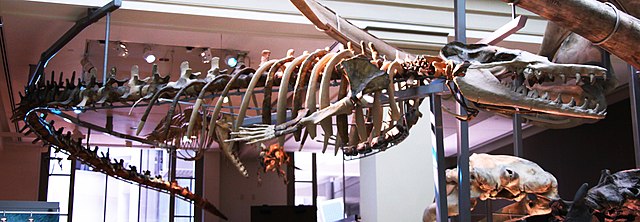Basilosaurus, a prehistoric marine mammal that lived during the Eocene epoch, approximately 40 to 34 million years ago, holds significant evolutionary importance. Here’s an exploration of the evolutionary significance of Basilosaurus:
1. Taxonomy and Classification:
- Mammalian Heritage: Basilosaurus belongs to the order Cetacea, which includes modern whales, dolphins, and porpoises.
- Primitive Features: Despite its ancient age, Basilosaurus exhibits features more reminiscent of terrestrial mammals than modern cetaceans.

2. Transition from Land to Sea:
- Ambulocetus Connection: Basilosaurus is part of the evolutionary transition from land-dwelling to fully aquatic whales. It follows organisms like Ambulocetus, indicating the gradual adaptation of terrestrial mammals to an aquatic lifestyle.
- Intermediate Anatomy: Basilosaurus retains limb bones in its body, indicative of its semi-aquatic nature. These vestigial limbs suggest an evolutionary stage between terrestrial and fully marine mammals.
3. Skeletal Evidence:
- Hind Limbs: Basilosaurus possesses tiny, non-functional hind limb bones, a feature shared with some modern whales. These remnants are evidence of its evolutionary history, tracing back to terrestrial ancestors with fully developed limbs.
4. Size and Adaptations:
- Length: Basilosaurus was a large marine mammal, with some individuals reaching lengths of about 60 feet (18 meters).
- Streamlined Body: Its body was elongated and streamlined, reflecting adaptations to an aquatic lifestyle.
5. Paleoenvironmental Insights:
- Oceanic Presence: Basilosaurus fossils have been found in marine deposits, indicating that it lived in ancient seas.
- Paleogeography: Its presence contributes to our understanding of the paleogeography of Eocene oceans and the ecosystems that supported early cetaceans.
6. Feeding Adaptations:
- Teeth and Diet: Basilosaurus had sharp, conical teeth adapted for catching fish and other marine prey. The structure of its teeth provides insights into the diet and feeding behavior of early whales.
7. Paleoecological Context:
- Coexistence with Other Species: Basilosaurus shared its ancient marine environment with various other marine life, including sharks, rays, and other early cetaceans.
- Ecological Niches: Understanding the ecological roles of Basilosaurus and its contemporaries helps reconstruct the complex interactions within Eocene marine ecosystems.
8. Biogeographic Distribution:
- Geographic Range: Basilosaurus fossils have been found in regions that were once part of ancient Tethys Sea, including present-day North Africa and the southeastern United States.
- Migration and Distribution Patterns: Studying the distribution of Basilosaurus fossils contributes to our understanding of migration patterns and the evolution of cetaceans in different parts of the world.
9. Evolutionary Adaptations for Swimming:
- Streamlined Body: Basilosaurus exhibits a body structure adapted for efficient swimming, a key feature in the evolutionary transition from land to sea.
- Tail Adaptations: Its long tail, with a fluke at the end, suggests a mode of swimming similar to modern cetaceans.
Basilosaurus, with its transitional features and adaptations to an aquatic lifestyle, plays a crucial role in the evolutionary narrative of cetaceans. Its fossils provide a valuable glimpse into the past, helping scientists unravel the complex journey that led to the emergence of the diverse marine mammals we see today.











